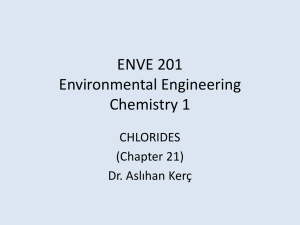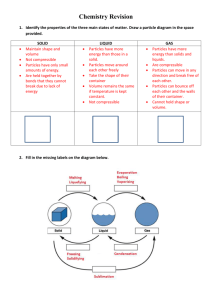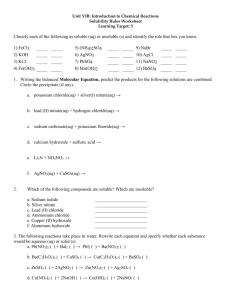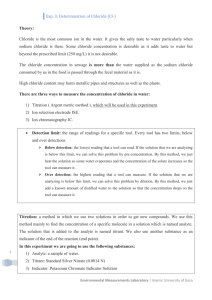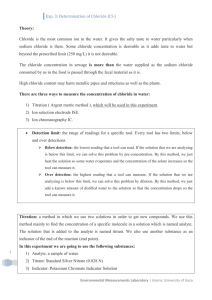SALT CONTENT BY TITRATION
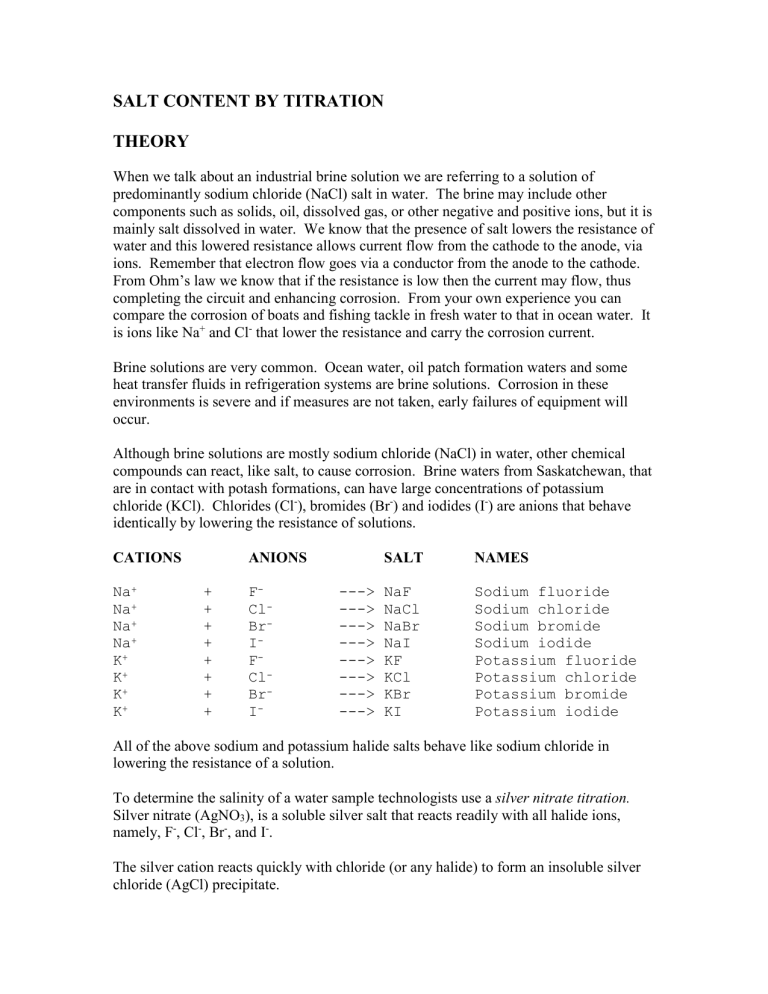
SALT CONTENT BY TITRATION
THEORY
When we talk about an industrial brine solution we are referring to a solution of predominantly sodium chloride (NaCl) salt in water. The brine may include other components such as solids, oil, dissolved gas, or other negative and positive ions, but it is mainly salt dissolved in water. We know that the presence of salt lowers the resistance of water and this lowered resistance allows current flow from the cathode to the anode, via ions. Remember that electron flow goes via a conductor from the anode to the cathode.
From Ohm’s law we know that if the resistance is low then the current may flow, thus completing the circuit and enhancing corrosion. From your own experience you can compare the corrosion of boats and fishing tackle in fresh water to that in ocean water. It is ions like Na + and Cl that lower the resistance and carry the corrosion current.
Brine solutions are very common. Ocean water, oil patch formation waters and some heat transfer fluids in refrigeration systems are brine solutions. Corrosion in these environments is severe and if measures are not taken, early failures of equipment will occur.
Although brine solutions are mostly sodium chloride (NaCl) in water, other chemical compounds can react, like salt, to cause corrosion. Brine waters from Saskatchewan, that are in contact with potash formations, can have large concentrations of potassium chloride (KCl). Chlorides (Cl ), bromides (Br ) and iodides (I ) are anions that behave identically by lowering the resistance of solutions.
CATIONS
Na +
Na +
Na +
Na +
K +
K +
K +
K +
ANIONS
+ F -
+ Cl -
+ Br -
+ I -
+ F -
+ Cl -
+ Br -
+ I -
SALT
---> NaF
---> NaCl
---> NaBr
---> NaI
---> KF
---> KCl
---> KBr
---> KI
NAMES
Sodium fluoride
Sodium chloride
Sodium bromide
Sodium iodide
Potassium fluoride
Potassium chloride
Potassium bromide
Potassium iodide
All of the above sodium and potassium halide salts behave like sodium chloride in lowering the resistance of a solution.
To determine the salinity of a water sample technologists use a silver nitrate titration.
Silver nitrate (AgNO
3
), is a soluble silver salt that reacts readily with all halide ions, namely, F
-
, Cl
-
, Br
-
, and I
-
.
The silver cation reacts quickly with chloride (or any halide) to form an insoluble silver chloride (AgCl) precipitate.
All silver halide salts are white to off-white and require an indicator to tell us when the precipitation reaction is over. Potassium chromate (K
2
CrO
4
), is a suitable indicator since a slight excess of AgNO
3
causes a bright red precipitate of silver chromate, Ag
2
CrO
4
.
BALANCED CHEMICAL REACTIONS:
CONCENTRATION RELATIONSHIPS:
1 molar solution = 1 M = 1 mol solute
1 L solution
1 part per million = 1 ppm = 1 mg or 1 mg
1,000,000mg 1 L solution
1 L solution = 1 L x 1000 mL x 1 g x 1000 mg = 1,000,000 mg (for dilute solutions)
1 L 1 mL 1 g
MATHEMATICAL RELATIONSHIPS:
To calculate the molarity of a sodium chloride solution:
Molarity (NaCl) x Volume (NaCl) = Molarity (AgNO
3
) x Volume (AgNO
3
)
M
1
V
1
=M
2
V
2
To calculate the parts per million of chloride ion: ppm Cl
-
= mole Cl
-
x 35.45 g/mole Cl
-
x 1000 mg/g sample volume in litres or
ppm Cl
-
= (Molarity of Cl
-
) x 35.45 g x 1000 mg mol Cl
g
To calculate the parts per million of sodium chloride: ppm NaCl = ppm Cl x 58.44 g/mole NaCl
35.45 g/mole Cl
- or ppm NaCl = (Molarity of NaCl) x 58.44 g x 1000 mg
mol NaCl g
PROCEDURE
1. Select “Hot Plate & Mag Stir” from the Equipment menu. Place 25.00 mL of an unknown brine solution into a 100 mL beaker. Place the beaker on the magnetic stirrer. Add 0.100 mL of potassium chromate. Select the magnetic stirrer and use the context menu to set the stirring rate.
2. Carefully fill a 50.00 mL burette with standardized silver nitrate solution. Zero the burette to 0.00 mL and position it over the 100 mL beaker.
3. Titrate the contents of the beaker with silver nitrate from the burette. Initially the silver nitrate may be added rapidly with continuous stirring. At this point, large amounts of white solid should be forming. Slow down subsequent additions of silver nitrate until a faint brick red precipitate forms indicating the end of the titration.
4.
Record all pertinent data on the data sheet. Read the burette volume to +/- 0.1 mL
.
5.
Repeat the titration until the final volumes agree to +/- 0.2 mL.
6.
Fill in the remainder of the data sheet and perform all calculations.
BE CAREFUL WITH SILVER NITRATE SOLUTIONS
Spills on your skin or the floor turn black on exposure to light. These stains are very difficult to remove from floor tiles, without grinding off the finish. These stains on skin take about a month for new skin to grow to replace the black stain.
REPORT
1. SHOW DETAILED CALCULATIONS FOR THE FOLLOWING:
Molarity of salt (NaCl) in the unknown:
ppm chloride (Cl
-
)in the unknown:
ppm salt (NaCl) in the unknown:
QUESTIONS
1. Consider the conductance meter and the titration method of determining the salt content of a brine sample. Discuss at least two advantages and two disadvantages of each method.
2. A corrosion technologist pipetted a 50.00 mL sample of an unknown brine and titrated it with 37.64 mL of 0.1024 M silver nitrate solution. Calculate the ppm salt (NaCl) in the sample.
3. If a salty crude sample was analyzed to have 110.6 ppm salts, calculate the pounds of salt per 1000 bbls of crude.
NAME: ____________________________
SECTION: _________________________ DATE:
______________________________
UNKNOWN INFORMATION : ___________________________________
SALT CONTENT OF A BRINE SOLUTION
CONCENTRATION OF STANDARDIZED SILVER
NITRATE:____________________
Trial #1 Trial #2 Trial #3
Pipetted volume
Final burette reading
Initial burette reading
Volume titrated
AVERAGE OF 2 BEST TITRATION’S: ___________________________________
